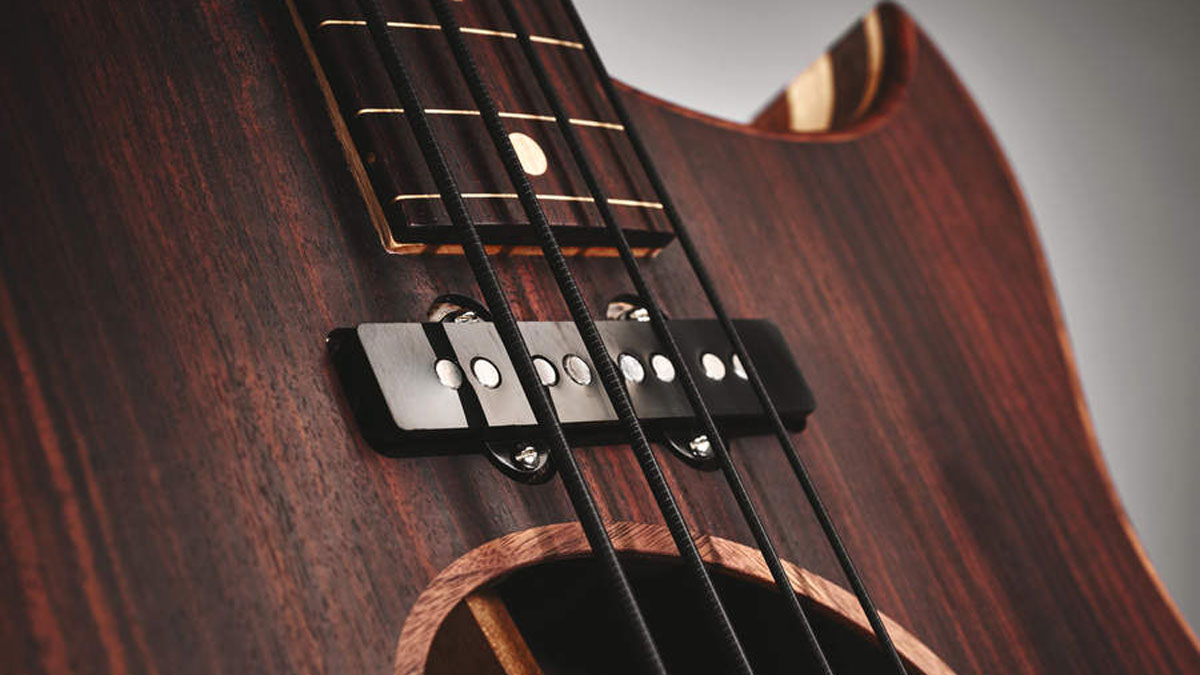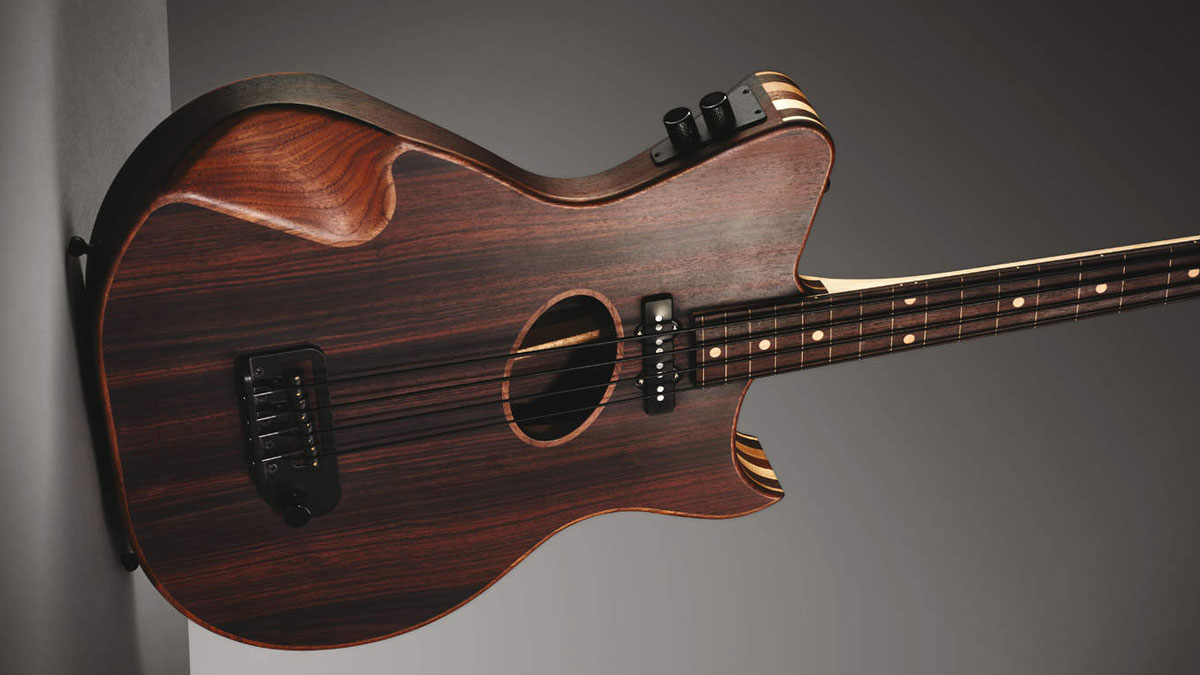MusicRadar Verdict
A superb instrument made to world-class standards.
Pros
- +
Plays beautifully.
- +
Sounds gorgeous.
Cons
- -
None, although traditionalists may be spooked.
MusicRadar's got your back
Back in the summer of 2017 we reviewed a Gillett Contour Standard, the older, thicker-bodied and slightly more expensive big brother of this S model, the S standing for ‘slimline’.
There’s also an ST model, the T meaning ‘transducer’. This has a Schatten under-bridge piezoelectric unit. Both the S and ST have presumably been developed by Somerset luthier Michael Gillett in response to players’ requests for a more slender instrument.
In the 2017 review we pointed out that the Standard was a big lump of a bass by any measure, which was a slight shame as its sheer dimensions obscured the incredible build and playability of the instrument. For that reason, we’ve been keen to get our hands on a Contour S and see how it measures up, literally and otherwise.
The bass reviewed here is a Contour S with the Schatten bridge transducer retro fitted, and is therefore identical to an out-of-the-box ST. The retro fit costs £250, for any Contour S owners who may be interested.
Build
As with the Standard, much time and effort at Gillett HQ has gone into enhancing the natural sound of the tonewoods used in the Contour S’s neck and body. Two significant parts of this process are the futuristic but eminently practical body chamfering, and the through-body stringing system; the former is visible to anyone, but the latter is mostly hidden.
It turns out that the last 4.75 inches of the 36-inch strings are within the body, giving us a playable scale of 31.75 inches. If you imagine the process of designing and repeatedly testing this system, you can get an inkling of where a large chunk of the £2450 asking price is going.
Our review model has a rosewood body and a maple neck. It’s fretless, with the rosewood ngerboard squeezing just 19 fret lines into that short scale. The chamfering on the body essentially comprises a huge concave chunk from the back, and a very welcome valley for your picking forearm on top of the body, itself a highly manageable 80mm in depth. The deeply wacky two-over-two headstock from the Standard is present and correct; personally it reminds us of one of Salvador Dali’s melting clocks, but that’s merely our opinion and not to be taken as gospel.

Two heavyweight controls appear on top of the body, with neither detente nor identifying label; they’re a volume pot for the Bareknuckle single-coil pickup located between the neck and the soundhole, plus an active tone boost/cut. The under-bridge piezo pickup also has its own volume control, located on the bridge, itself an impressively solid custom Gillett job.
Throughout, the construction is flawless, or at least it is to my eyes. The details have all been taken care of - there are three strap buttons, with two at the rear to choose from; the battery compartment is a slick, magnetic popout unit; and there’s a height-adjustable nut for anyone reluctant to mess with the bridge saddles.
Before we dig into the sounds available, take note that a certain tone range is inevitable, because this review model has been strung with black Rotosound Tru Bass flatwounds, coated in nylon. These were originally designed by Rotosound founder James How for the Jim Burns Black Bison bass in 1962, the idea being to emulate an upright bass tone on a bass guitar.
We’re suckers for a Bison bass, as all right-thinking bassists should be, but anyone seeking a brighter sound should opt for Newton Acoustics phosphor bronze strings, which we confidently predict will make a sound the polar opposite of these black beauties.
Sounds
The volume is almost zero unplugged, so hook the Contour up to the amp of your choice and have a tweak of the controls. The heart of the instrument’s tone comes from its preamp, a Gillett custom unit (there’s another lump of the £2450 accounted for) which has been specifically designed to complement the two pickups, minimise noise and maximise signal-to-noise ratio. Should you wish to boost or cut the top or bottom end, bear in mind that the tone pot is a little idiosyncratic, boosting bass and cutting treble when rolled anticlockwise and vice versa. Those accustomed to separate top and bottom boosts will need to spend a minute getting used to this idea.
Once you’re on board with all this, the default tone is what you’d expect from a fretless with flats - warm, sinewy and pretty dead. It’s a near-perfect analogue of a certain double bass tone, that’s for sure, but if you want more life to the sound you can inject it via the tone control or by rolling on the piezo pickup for a bit of clank. The string volume is impressively consistent up the neck and across each string, while the sustain is marvellous thanks to the through-stringing system.
With these strings, true top end and even high mids aren’t abundant, so if that’s the sound you need - and frankly, most of us will at some point - select different strings. Don’t even try to slap. On the other side of the coin, reggae, Motown and hip-hop bassists will be in heaven with these nylons; their slick mwah is there for the taking as soon as you plug in.
In terms of playability, we’re pleased to confirm that the 80mm body depth solves the issues we had with the Standard instrument, especially given the wrist valley. Hug the bass close and enjoy its amazing sustain without having to strain any of your shoulder muscles. This bass has been set up with a super-low action and this, combined with a slick rear neck finish, makes it a joy to play. The string spacing of 41mm at the nut is friendly, and while a thumb rest might have come in useful, you’ll have little problem sliding all over the fingerboard.
Marry great design to an awareness of a musician’s real-life needs and you’ve got a chance of creating a good instrument - that’s definitely been the case here. Sure, the looks of the Contour will still alienate traditionally-minded bassists, but so what? The proof is in the playing, and this bass is eminently playable. Great job all round.
“A synthesizer that is both easy to use and fun to play whilst maintaining a decent degree of programming depth and flexibility”: PWM Mantis review
“I feel like that song had everything we needed to come back with”: Bring Me The Horizon’s Lee Malia on Shadow Moses, its riff and the secrets behind its tone, and why it was the right anthem at the right time
“I said, ‘Are we sure we can write a song about death?’”: The story of Mike + The Mechanics' classic No.1 The Living Years










